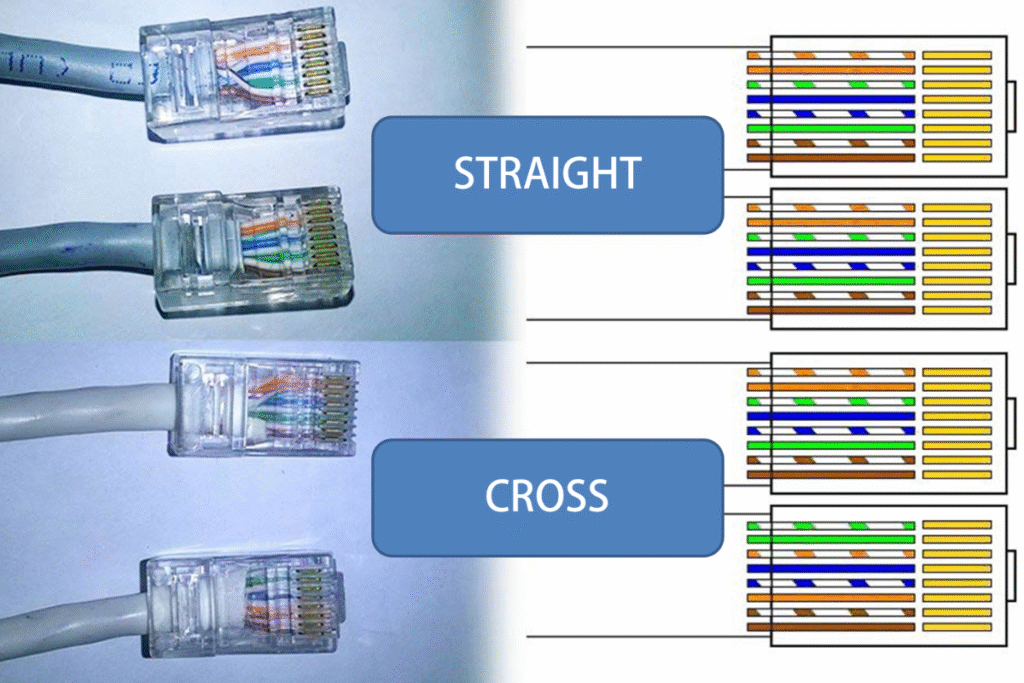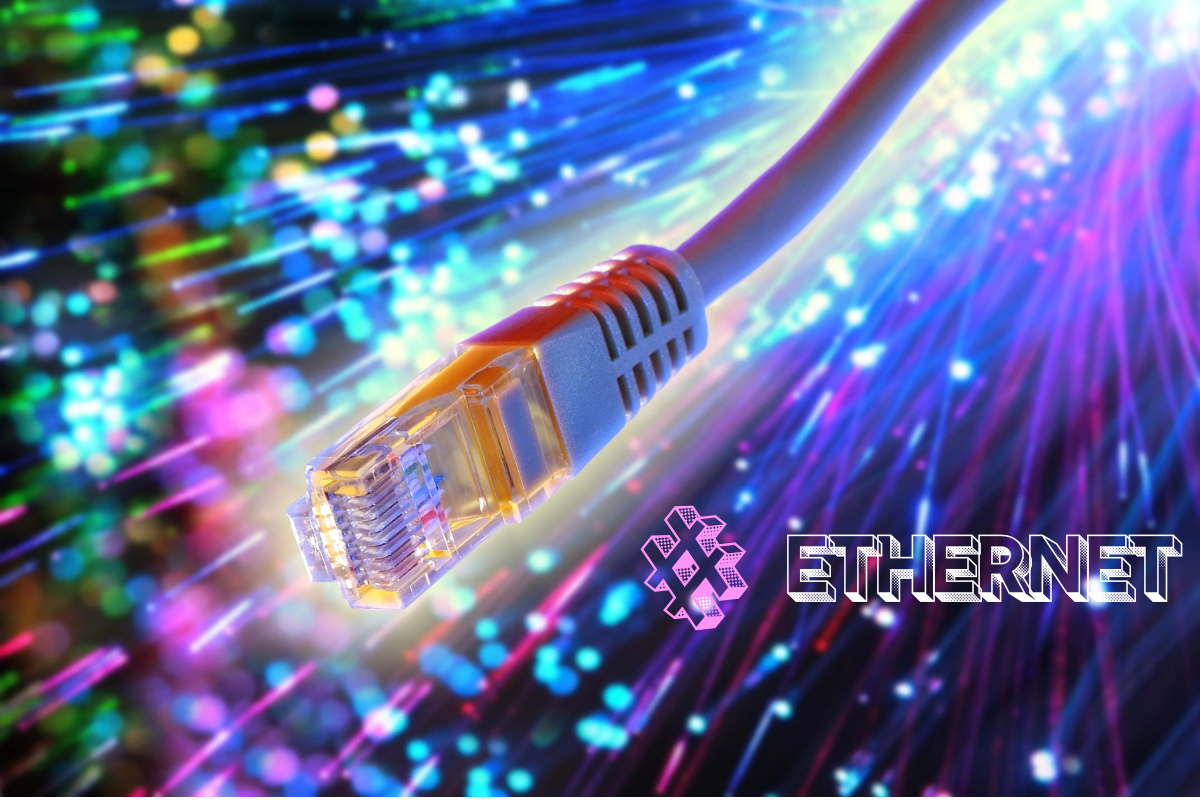Ethernet is a constantly in-demand networking technology utilized to support devices like computers, printers, and gaming consoles to share information and communicate with each other on a local area network (LAN). It is equally famous to be speed, reliable, and low-latency, hence adopted as the preferred technology for enterprise and home networks. In contrast to radio wave-based Wi-Fi, Ethernet uses wired connections to ensure uniform performance.
Under the Ethernet connection is the Ether-net cable, and you can see and touch it and use it to connect your device to a modem, switch, or router. Cables also exist in different types such as Cat5e, Cat6, and Cat8 with different speeds and bandwidth capabilities. With the right Ethernet cable, you are assured of the best speed and connection for your internet activities whether streaming 4K content, gaming, or downloading big files.
Ether-net operates by carrying data packets through these cables with minimal or zero interference and a steady link. Therefore, it is best used in applications that require a constant and fast internet connection. The majority of businesses continue to use Ethernet since it is more secure than wireless connections, reducing the possibility of malpractice.
Tracing the Evolution of Ethernet
Ethernet is traced back to the early 1970s when Robert Metcalfe of Xerox PARC came up with it. It was initially designed as a way of connecting computers in a local area network (LAN) and later as an industry standard due to its reliability, speed, and flexibility. Over the years, Ether-net has gone from offering a speed of just 2.94 Mbps to standards that currently exist and which are now up to 400 Gbps, moving at the same pace as changing business, not to mention household, requirements.
One of the most significant advances in Ethernet technology has been the invention of the Ethernet cable. It used to use heavy coaxial cables that were a hassle to handle. Now we use twisted pair cables like Cat5e, Cat6, and Cat8 which are easy to install and more flexible but far faster. With each successive generation of Ethernet cable, there is more bandwidth and less interference, so it can provide more and more optimized wired networking.
The application of Ethernet cable also revolutionized how devices communicate with one another. From connecting just computers in the laboratory setup, Ether-net now powers whole office networks, gaming consoles, streaming media players, and smart homes. Its tangibility can still not be surpassed, especially in a setting where speed and security take priority.
How Ethernet Connections Really Work
An Ether-net connection might appear boring, but in the background, it is a very step-by-step process to deliver a quick and error-free internet. This is what happens step by step:
1. Device to Cable Connection
Your TV, laptop, or gaming console is attached to the network using an Ethernet cable that is plugged into its port.
2. Cable to Network Hardware Connection
The Ethernet cable connects your device with a modem, router, or network switch that directs and controls the data flow.
3. Data Packet Transmission
The data is divided into small data packets. The packets are transmitted on the Ethernet cable as electrical impulses in order to be sent efficiently and in a timely manner.
4. Routing and Switching
The router or switch determines where the data packet needs to go and sends it to the destination device or onto the internet.
5. Error Checking
Error checking when transmitting is an Ether-net technology function that will keep the connection going and avoid packet loss.
6. Data Reception
Your computer pulls the packets in, reconstructs them, and interprets the data—loading a webpage, watching a video, or online game.

In milliseconds, it does this, supporting Ether-net as quickly and as dependable. A quality Ethernet cable eliminates interference and allows you to get a strong performance, so it’s an excellent choice for work, streaming, or playing games.
Ethernet vs. Wireless Speeds
Internet-wise, Ether-net and wireless each have their advantages, although Ether-net tends to be faster and more dependable. In contrast to Wi-Fi, which is degraded by distance, walls, and other types of signal interference, Ether-net utilizes a wire to provide solid performance. This makes it particularly suited for activities such as online gaming, streaming high-definition movies, and bulk file transfers.
Having an Ethernet splitter allows several devices to be plugged into a single network port without losing too much performance. That is, an Ethernet splitter is useful in the sense of doubling connections but does not double bandwidth. The speed present will be shared among devices, so use will be dependent upon performance.
Wireless systems have come a long way with developments like Wi-Fi 6, which offer amazing speed and convenience. Even with all that technology, Ether-net is still lower latency and less prone to interference, especially when there are a lot of devices present. Pairing your installation with a quality cable and an Ethernet splitter allows you to have several plugged-in devices and yet enjoy good performance.
Different Types of Ethernet Cables
Once you have a network up, once you know about the types of Ethernet cables, then you can choose the best one for you based on your needs. They are diverse in terms of speed, bandwidth, and shielding. The right cable allows your devices to run at the best speed with your Ethernet switch so that it will run perfectly well without any fault. Types of Ether-net Cables used:
- Cat5e – It can support up to 1 Gbps; common home use exploits this.
- Cat6 – Up to 10 Gbps at shorter distances; ideally used in offices or gaming desktops.
- Cat6a – Improved shielding to reduce interference; ideally used for high-speed use.
- Cat7 – Up to 10 Gbps with improved noise shielding; used in professional settings.
- Cat8 – The fastest of the bunch, supporting up to 40 Gbps; ideal application in data centers.
Your cable selection decides how well your Ethernet switch processes and deals with traffic between equipment. For example, where your switch is capable of gigabit speeds, using Cat6 and above ensures you the best performance.
Steps to Build Ethernet Network
To have an Ethernet network installed is the ultimate solution to get fast, strong, and secure internet connections for your office or home. With the right installation, you will be able to have a network that is connected to more than one device at a time with zero lag or obstacle. An Ethernet switch will help you expand the wired network so that you will have more devices without any lag. Steps to Build an Ethernet Network
- Map Out Your Cable Run – Decide where your router, Ethernet switch, and devices will be located and map out the best cable run in your setup.
- Select a Quality Ethernet Cable – Cat6 or better is ideal for more speed and less interference.
- Install Your Router or Modem – Hook it up to the main internet cable so that it is the hub of your network.
- Plug in the Ethernet Switch – Plug the router into the switch and then devices into the switch.
- Install Cables on Every Device – Supply every device directly with good cables into the network.
- Set Network Options – Set devices to utilize wired connections for enhanced performance.
- Test the Connection – Test speed and stability to confirm that your Ether-net network is running optimally.
An Ethernet switch gives numerous devices the capability to connect to one place without compromising performance. Your Ether-net network will deliver uninterfered speeds for business, streaming, and gaming with the right cables, installation, and setup.
Why Gamers like Using Ethernet
To gamers, milliseconds count, and most gamers therefore prefer Ether-net over wireless connections. The wired connection is more stable, faster, and less laggy, which might be the difference between winning or losing while playing competitive games. Ether-net is a consistent connection that ensures smooth gaming compared to Wi-Fi, whose signals tend to stutter and at the same time be susceptible to interference.
The majority of the satellite internet customers connect their device using a Starlink Ethernet adapter and directly into the network. The Starlink Ethernet adapter allows the customer to bypass Wi-Fi and enjoy the finest of cable connectivity even when connected with Starlink’s satellite high-speed internet. This is highly beneficial for rural communities that lack access to traditional broadband.
By connecting a gaming computer or console to a Starlink Ethernet adapter, players are escaping lag and packet loss, two of the biggest issues that can be such a pain playing online. The adapter works well with a router and provides an uninterrupted wired data transmission path.
Gaming fans would like to know that an Ether-net adapter for Starlink can also be used in conjunction with good quality Ether-net cables to deliver maximum performance. From an instant action game to a massive online role-playing game, gaming on Ether-net connection using the adapter is still the market leader.
Frequently Asked Questions
1. What is Ethernet?
Ether-net is cabling technology that connects devices like computers, smart TVs, and gaming consoles to a local area network (LAN) for rapid and secure internet.
2. Is Ethernet faster than Wi-Fi?
Yes. Ethenet generally offers higher speeds, low latency, and reliable performance compared to Wi-Fi and is therefore best for gaming, streaming, and video calling.
3. What do I need for Ethernet?
To connect Ether-net, you will need an Ethernet cable, a router or modem, and perhaps an Ether-net switch if you have more than one device that you don’t wish to connect.
4. Will Ether-net be compatible with my existing internet provider?
Yes. If your provider is able to provide a hardwired connection through a router or a modem, you can integrate Ether-net into your system without issue.
Key Takeaways
Ether-net remains among the highest performing and most dependable of the network solutions today. Ether-net is faster, less lag-intensive, and more secure than much of its wireless competition, and ideally suited for computer gaming, video streaming, and business applications. Ether-net technology has evolved over the years with the ability to handle greater bandwidths along with advanced, green-friendly features like Energy Efficient Ethernet.
Energy Efficient Ethernet or EEE is power-saving technology that occurs under low network usage. Rather than sending at full power all the time, Energy Efficient Ether-net senses that data transfer is low and reduces power consumption without compromising performance. It is ideal for small businesses and home clients who want to reduce electricity bills without ever compromising an uncompromising wired connection.
Through the use of Energy Efficient Ether-net, the networks are optimized to the extent that they conserve a lot of energy, even in multiconfigurations within devices or even in large data centers. Through the use of standard Ether-net cables or even superior switches, usage of Energy Efficient Ethernet makes your network as green-proof as possible.
For more : CrowdStrike Outage 2025: Causes, Consequences, and Fixes


